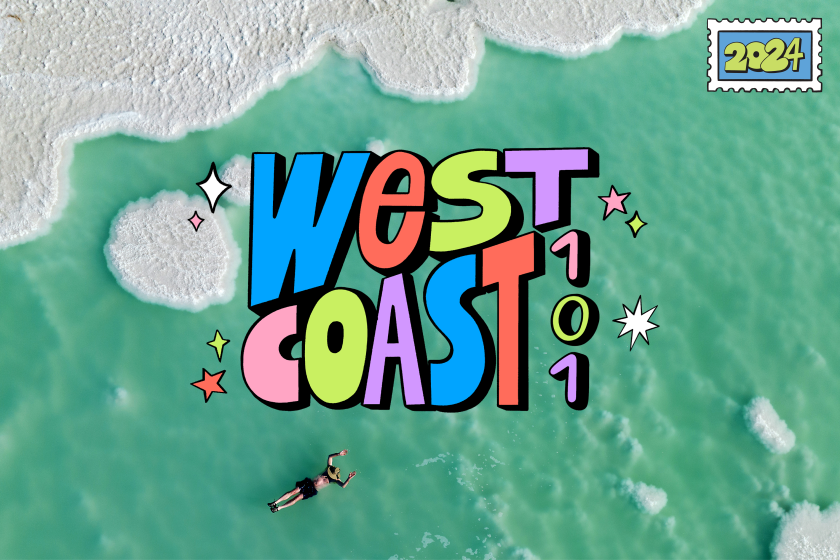RECREATION / STEVE HENSON : Endurance Test in Wilderness Wasn’t a Watered-Down Affair
The idea was to test yourself in unimaginable ways, spending eight days hiking, rafting, climbing, canoeing, mountain biking and horseback riding in the user-unfriendly wilderness of Utah.
The idea was not to drink water colored orange with cattle urine.
The five members of Team Endeavour had a choice while standing in the desert on their third day: They could have gulped the orange stuff or they could have turned instead to stagnant water from an abandoned well full of dead rats.
“We opted for Chez Bovine,” said Bill Lovelace, safe at home in West Hills after surviving the first Eco-Challenge along with his wife, Louise, and other teammates Kirk Boylston, Doug Wilde and Duane McDowell.
Actually, they slew the race, which ended May 3 at Bullfrog Marina in Lake Powell. Team Endeavour placed eighth out of 50 teams--only 21 finished--and qualified for the Extreme Games, to be held in New England in late June.
“The Extreme Games will be pretty much the same thing we just did, except that there will be sea kayaking,” said Boylston, 37, of Calabasas. “Only 12 teams from around the world are invited, so the competition will be more intense.”
And the water couldn’t be worse.
On the afternoon of their third day, Team Endeavour found itself 20 miles from a checkpoint where fresh water would be provided. The rat-filled well and the natural spring used as a bovine latrine were alternatives to quitting.
Already the team had ridden 28 miles on horseback and hiked until midnight the first day, then slogged neck-deep in freezing snow-melt through a canyon the second day.
Quitting was not on the menu.
“It was horrible and I think several teams dropped out when they reached that water hole,” Lovelace said. “You can’t imagine what it tasted like.”
Team Endeavour hiked the 20 miles across parched desert to the next checkpoint by 8 p.m., slept until 1 a.m., then hiked another 25 miles, reaching the mountain biking portion of the race by noon.
The next several days were a blur of little sleep and lots of movement.
Mountain biking 35 miles was a bit of a respite, except they all had 45-pound packs on their backs.
“I think we had the heaviest backpacks of any team,” Boylston said. “We’ll know better next time.”
Breathtaking adventure was next. They rappelled 400 feet down a cliff, shimmied across a pulley called a Tyrollian Traverse to get from one mountain peak to another, rappelled four more times to the bottom of another canyon, and hiked to the rafting portion of the race.
All in a day’s work.
“We climbed from 16th to 8th place,” Lovelace said. “We were passing people who had to pause and rest. We out-endured other teams.”
Rafting treacherous rapids in Cataract Canyon on the Colorado River in an intense hailstorm was next, and along the way Team Endeavour rescued members of a French team whose raft capsized .
“That part was fun, really a gas,” Lovelace said.
All fun must come to an end, however, and Team Endeavour had reached the race’s final day.
“We started at 3 a.m. in the raft and paddled in the pitch dark through a thunderstorm,” Lovelace said. “If it wasn’t for the current and for flashes of lightning, we wouldn’t have known where we were.”
By 7 a.m. they’d reached the end of their rope and the beginning of a 1,200-foot unaided climb up a sheer cliff. Officials from the Guinness Book of World Records were on hand to document the effort.
Three hours later, they were at the top, embarking on a 10-mile hike to the last of the race’s four assistance points. Then they hopped into a canoe and paddled about 12 hours to the finish line.
Team Endeavour had gone from here to tarnation in seven days, 22 hours--only six hours behind first-place Hewlett-Packard.
“There was not ever a point where thought we wouldn’t make it,” Boylston said.
Team Endeavour, easily the team with the oldest members among the top 10 finishers, had become something of a sentimental favorite. Bill Lovelace is 47, Louise is 41 and the other men are in their late 30s.
“This is not an event that hurts you by being older,” Boylston said. “Most of the kids’ teams crashed early. It is as much mental as physical, maybe more so. And we had an advantage there.”
Recuperation took only a couple of days. Team Endeavour is already training for the Extreme Games.
“We went mountain biking and running yesterday,” Boylston said. “We do this all the time anyway.”
*
Team Endeavour was helped in its training by Cal State Northridge professors George Holland and Tommy White, and graduate student Patty Melody.
Holland, an exercise physiologist, and Melody developed a high-fat diet for the team. White, a sports psychologist, worked with the team’s mental approach.
Holland and Melody attended the race and plan to include many of the teams in their research.
“There has never been anything quite like this and we want to develop a descriptive analysis on how to best prepare,” said Melody, who is especially intrigued by the role that sleep deprivation played in the race.
*
Eco-Challenge organizer Mark Burnett, whose offices are in Studio City, faced as many obstacles as the competitors. He has grand plans for the Eco-Challenge, hoping to stage at least one a year at various locations, but he says he won’t return to Utah.
And that doesn’t bother federal and Utah state officials, who were somewhat hostile to the entire concept. The Bureau of Land Management and National Park Service forced Burnett to change routes and pay for environmental impact reports.
“Uncompromising environmentalists cost us hundreds of thousand of dollars and most of our energy,” Burnett said.
“We left the desert in better shape than we found it.”
Officials were less concerned with the actual impact of the event than the fact that the pristine Utah wilderness will be showcased to millions when segments of the Eco-Challenge are televised on MTV this summer.
“The message this race sends is to come beat us up,” said Dean Reeder, director of the Utah Travel Council. “It is the challenge of man against nature.”
Don Banks of the Bureau of Land Management said that Burnett had complied with the 35 environmental stipulations the agency required.
The $75,000 paid in fees by Eco-Challenge will be used to assess impacts of the race.
“The race had zero impact on the environment,” said Kirk Boylston of Team Endeavour. “I have mixed feelings about it. You need (officials) watching people, but they went overboard in this case.
“I don’t think people will see this on TV and want to go there. It’s very beautiful, but the type of person who is going to toss beer cans and candy wrappers is not going to seek this out. It’s too remote.”
Not to mention the contaminated water.
Sign up for The Wild
We’ll help you find the best places to hike, bike and run, as well as the perfect silent spots for meditation and yoga.
You may occasionally receive promotional content from the Los Angeles Times.




